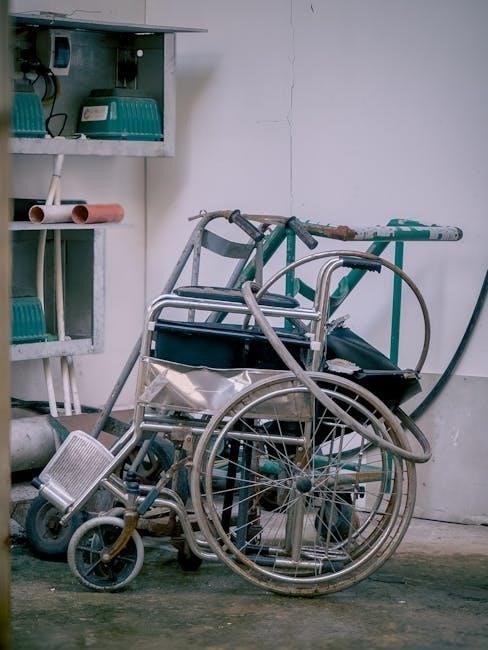Manual stand-up wheelchairs are innovative mobility aids designed to enable users to transition between sitting and standing positions, promoting independence and enhanced quality of life;
1.1 Definition and Purpose
A manual stand-up wheelchair is a mobility device designed to enable users to transition between sitting and standing positions. It combines the functionality of a traditional manual wheelchair with a mechanism that allows the user to stand upright. The primary purpose is to enhance mobility, independence, and overall quality of life for individuals with mobility impairments. These wheelchairs are engineered to promote better circulation, muscle tone, and social interaction by enabling users to engage in activities at eye level with others. They are ideal for those seeking a cost-effective, non-powered solution to improve their daily living experiences.
1.2 Brief History and Evolution
Manual stand-up wheelchairs have evolved significantly over the years, originating from basic mobility aids to sophisticated devices. Early models were simple, focusing on seated mobility, but advancements in materials and design led to the development of standing functionality. The introduction of lightweight materials like aluminum and carbon fiber enabled the creation of durable yet portable chairs. Modern manual stand-up wheelchairs now incorporate ergonomic designs, adjustable features, and safety mechanisms, addressing the needs of users seeking independence and improved health outcomes through standing mobility.

Key Features of Manual Stand-Up Wheelchairs
Manual stand-up wheelchairs feature lightweight frames, adjustable seat heights, and robust safety harnesses, ensuring durability, comfort, and secure transitions between sitting and standing positions effortlessly.
2.1 Lightweight and Durable Design
Manual stand-up wheelchairs are crafted with lightweight yet durable materials, such as aluminum frames, ensuring ease of mobility while maintaining structural integrity. Their compact design allows for seamless navigation in tight spaces, enhancing user independence. The robust construction withstands regular use, providing long-term reliability and safety. This balance of portability and strength makes them ideal for daily use, catering to individuals who prioritize both mobility and durability in their assistive devices.
2.2 Manual Operation Mechanism
The manual operation mechanism of stand-up wheelchairs allows users to transition between sitting and standing positions through physical effort. These chairs are propelled like standard manual wheelchairs, with the user pushing the wheels to move. The standing function is typically activated by a lever or crank, enabling the user to shift their position. This mechanism relies on the user’s strength and control, making it a cost-effective and reliable option for those who prefer or require non-powered mobility solutions. The design ensures stability during transitions, providing a seamless experience for independent use.
2.3 Adjustable Seat Height and Depth
Manual stand-up wheelchairs often feature adjustable seat height and depth settings, allowing users to customize their fit for optimal comfort and support. Seat heights typically range from 48 to 57 cm, while seat depths can extend up to 54 cm, accommodating various body types. This adjustability ensures proper posture, reduces the risk of discomfort, and enhances overall mobility. By tailoring the seat dimensions to individual needs, users can maintain independence and enjoy a more comfortable experience.
2.4 Safety Harness and Support Systems
Manual stand-up wheelchairs are equipped with robust safety harnesses and support systems to ensure user stability during transitions. These systems include adjustable straps, pelvic supports, and secure fastening mechanisms to prevent shifting or falling. The harnesses are designed to distribute force evenly, providing maximum protection while allowing freedom of movement. Additionally, some models feature anti-tip wheels and wide bases for enhanced balance, ensuring safe standing and sitting maneuvers. These safety features are essential for building confidence and preventing accidents, making the wheelchair both reliable and user-friendly.

Benefits of Using a Manual Stand-Up Wheelchair
Manual stand-up wheelchairs enhance mobility, independence, and overall well-being by allowing users to stand, improving circulation, muscle tone, and social interaction while being cost-effective compared to powered models.
3.1 Improved Mobility and Independence
Manual stand-up wheelchairs significantly enhance mobility and independence by allowing users to transition between sitting and standing effortlessly. This feature enables individuals to engage in daily activities without relying on others, fostering self-reliance. The ability to stand upright not only improves physical posture but also empowers users to interact with their environment more comfortably. Additionally, the manual operation ensures users can navigate various terrains and spaces with confidence, making it an ideal solution for those seeking greater autonomy in their lives.
3.2 Health Advantages of Standing
Standing in a manual stand-up wheelchair promotes better posture, strengthens muscles, and improves circulation. It helps prevent pressure sores and joint contractures, common issues with prolonged sitting. Regular standing also enhances respiratory and digestive functions by allowing organs to operate more naturally. Users often experience reduced stiffness and improved overall physical comfort. These health benefits contribute to a higher quality of life and long-term well-being for individuals with mobility challenges.
3.3 Enhanced Social Interaction
Manual stand-up wheelchairs foster enhanced social interaction by allowing users to engage at eye level with others, reducing feelings of isolation. Standing upright enables natural communication and participation in group activities, promoting equality and confidence. This ability to connect face-to-face strengthens relationships and fosters a sense of community, making social interactions more meaningful and inclusive.
3.4 Cost-Effectiveness Compared to Powered Models
Manual stand-up wheelchairs are often more cost-effective than powered models, as they require less complex and expensive technology. They rely on user propulsion and manual mechanisms, reducing production and maintenance costs. This makes them a budget-friendly option for individuals seeking a standing wheelchair without the high price tag of powered alternatives. While they may lack the convenience of motorized operation, their affordability and durability provide long-term savings, making them a practical choice for many users.

Types of Manual Stand-Up Wheelchairs
- Superstand: A manual model ideal for active users, offering a sturdy frame and easy transition.
- Levo: Known for customizable seat options and durability.
- Lightweight Sport: Designed for quick standing and portability.
- Folding vs. Rigid: Folding models prioritize convenience, while rigid frames enhance stability.
4.1 Superstand Manual Standing Wheelchair
The Superstand Manual Standing Wheelchair is a user-propelled mobility aid that combines the functionality of a standard manual wheelchair with the ability to stand upright. Designed for independence, it features a lightweight and durable frame, allowing users to transition seamlessly between sitting and standing positions. The standing mechanism is manually operated, providing control and ease of use. Its compact design and robust construction make it ideal for daily use, offering enhanced mobility and the freedom to engage in activities while standing.
4.2 Levo Manual Standing Wheelchairs
Levo manual standing wheelchairs are renowned for their durability and versatility, offering users the ability to transition seamlessly between sitting and standing. These wheelchairs feature adjustable seat depths and heights, accommodating a wide range of user needs. With configurations that prioritize both functionality and comfort, Levo models are ideal for individuals seeking enhanced mobility. Their lightweight design and robust construction ensure long-term reliability, while the manual operation mechanism provides independence. Levo wheelchairs are also backed by extensive warranties, making them a trusted choice for users worldwide.
4.3 Lightweight Manual Sport Wheelchairs
Lightweight manual sport wheelchairs are designed for active individuals seeking enhanced mobility and independence. These chairs feature a quick-standing mechanism, allowing users to transition seamlessly between sitting and standing. Built with durable yet lightweight materials, they prioritize portability and ease of use. Ideal for sports enthusiasts or those with active lifestyles, these wheelchairs combine functionality with a sleek design. Their compact frames and adjustable features ensure a personalized fit, making them a popular choice for users who value both performance and comfort in their daily activities.
4.4 Folding vs. Rigid Frame Models
Manual stand-up wheelchairs come in folding and rigid frame models, each catering to different user needs. Folding models are lightweight, portable, and easy to store, ideal for users who require frequent transportation. Rigid frames, while heavier, offer superior durability and stability, often preferred by active users. The choice depends on lifestyle, with folding frames prioritizing convenience and rigid frames emphasizing long-term performance and reliability.

How Manual Stand-Up Wheelchairs Work
Manual stand-up wheelchairs operate via a user-controlled mechanism, allowing individuals to transition from sitting to standing using leverage or cranking systems, ensuring stability and safety during movement.
5.1 User-Operated Standing Mechanism
The manual stand-up wheelchair features a user-operated mechanism that allows individuals to transition from sitting to standing with physical effort. This typically involves a lever or handle system that the user activates to engage the standing function. The process requires strength and coordination but provides independence. The mechanism is designed for smooth transitions, ensuring stability and safety. While it demands physical exertion, it offers a cost-effective solution compared to powered models, making it ideal for those seeking simplicity and reliability in their mobility aid.
5.2 Transitioning from Sitting to Standing
Transitioning from sitting to standing in a manual stand-up wheelchair involves a user-operated mechanism that securely lifts the individual to an upright position. The process typically begins with the user shifting their weight and engaging the standing mechanism, which may include levers or handles. The chair is designed to provide stability during the transition, ensuring a smooth and controlled movement. Safety harnesses and support systems are often integrated to prevent accidents and maintain balance. This feature empowers users to independently switch between positions, enhancing their mobility and confidence.
5.3 Stability and Balance Features
Manual stand-up wheelchairs are equipped with advanced stability and balance features to ensure safe transitions between sitting and standing. These include wide, sturdy bases and anti-tip wheels to prevent tilting. Additionally, many models incorporate harness systems and secure seating to maintain user balance during movement. The robust frame designs and low center of gravity further enhance stability, allowing users to stand confidently without compromising safety. These features are essential for maintaining equilibrium and providing a seamless experience for individuals using manual stand-up wheelchairs.

Choosing the Right Manual Stand-Up Wheelchair
Assess user needs, measure for proper fit, and evaluate warranty options to ensure the best match for mobility, comfort, and independence.
6.1 Assessing User Needs and Preferences
Evaluating the user’s lifestyle, mobility, and personal preferences is crucial when selecting a manual stand-up wheelchair. Consider factors like weight, height, and physical limitations to ensure proper fit. Assess whether the user prioritizes portability, durability, or specific features like adjustable seat height. Lifestyle needs, such as daily use or sports activities, also influence the choice. Testing the chair for comfort and ease of use ensures a suitable match. Additionally, evaluating warranty and support options provides long-term security. A thorough assessment guarantees the wheelchair meets the user’s unique requirements, enhancing independence and satisfaction.
6.2 Measuring for Proper Fit
Accurate measurements are crucial for a manual stand-up wheelchair to ensure optimal comfort and functionality. Key measurements include seat height, depth, and width, as well as backrest height. Consider the user’s leg length to avoid pressure points and ensure proper footrest positioning. Torso length and shoulder height are also important for aligning the backrest correctly. Weight capacity should be checked to guarantee safety and stability. Adjustable features like seat depth and height can be tailored to individual needs, ensuring a secure and comfortable fit. Professional assessment is recommended for precise measurements.
6.3 Evaluating Warranty and Support Options
When selecting a manual stand-up wheelchair, it’s crucial to evaluate the warranty and support options provided by manufacturers. Look for comprehensive coverage, including parts and labor, typically ranging from 1 to 5 years. International warranties are ideal for global users. Additionally, assess the availability of customer service, maintenance support, and repair services. Reliable support ensures longevity and proper functionality of the wheelchair. Comparing warranty terms and support services across brands can help make an informed decision, ensuring peace of mind and protection for your investment.

Maintenance and Care Tips
Regular cleaning and lubrication of moving parts ensure smooth operation. Check brakes and stability systems frequently. Proper storage and transportation prevent damage, extending the wheelchair’s lifespan.
7.1 Regular Cleaning and Lubrication

Regular cleaning and lubrication are essential for maintaining the functionality of a manual stand-up wheelchair. Use a soft cloth and mild detergent to wipe down frames, seats, and moving parts. Lubricate joints, axles, and hinges periodically to ensure smooth operation. Avoid using harsh chemicals or excessive water, which can damage materials or electrical components. Inspect for wear and tear, and address any issues promptly to prevent breakdowns. Proper maintenance extends the lifespan and performance of the wheelchair, ensuring safety and reliability for the user.
7.2 Checking Brake and Stability Systems
Regularly inspecting the brake and stability systems of a manual stand-up wheelchair is essential for safety. Check the brake pads for wear and ensure they engage smoothly. Test the stability mechanisms to confirm they hold the chair securely in both sitting and standing positions; Lubricate moving parts to maintain optimal function. Address any damage or wear promptly to prevent accidents. Always refer to the manufacturer’s guidelines for specific maintenance instructions tailored to your model.
7.4 Storage and Transportation Guidelines
Proper storage and transportation of manual stand-up wheelchairs are crucial for maintaining their functionality. Always clean the chair before storing it in a dry, cool place to prevent damage. Folding models are ideal for compact storage, while rigid frames may require more space. For transportation, use vehicle-mounted carriers or secure the chair in a car with straps. Ensure the chair is tightly fastened to avoid movement during travel. Regularly inspect the chair for damage before and after transportation to ensure safety and longevity.

User Experiences and Testimonials
Users praise manual stand-up wheelchairs for enhancing independence and confidence, with many highlighting improved social interactions and emotional well-being from standing upright naturally.
8.1 Real-Life Stories of Users
Users of manual stand-up wheelchairs often share inspiring stories of how these devices have transformed their lives. Many highlight the newfound independence and confidence gained from being able to stand upright. For instance, Sarah, a user of the Superstand wheelchair, mentions how it has enabled her to interact more easily with family and friends, reducing feelings of isolation. John, another user, praises the Levo model for its durability and ease of use, allowing him to participate in outdoor activities he thought were lost forever. These testimonials underscore the profound impact of manual stand-up wheelchairs on daily living and emotional well-being.
8.2 Feedback on Performance and Comfort
Users praise manual stand-up wheelchairs for their durability and ease of use. The Superstand model is noted for its smooth transition between sitting and standing, while the Levo series is lauded for its adjustable features, ensuring a comfortable fit. Many highlight the lightweight sport models for their portability and support during active lifestyles. Overall, feedback emphasizes enhanced mobility, comfort, and independence, making these wheelchairs a practical choice for daily use.

Future Trends in Manual Stand-Up Wheelchairs
Advancements in lightweight materials, integration of assistive technologies, and customization options are expected to enhance mobility, comfort, and accessibility in future manual stand-up wheelchair designs.
9.1 Advancements in Lightweight Materials
Recent advancements in lightweight materials have significantly improved the performance of manual stand-up wheelchairs. Aluminum alloys and carbon fiber are now widely used, reducing weight while maintaining durability. These materials enable easier propulsion and enhanced portability. Innovations like titanium frames further minimize weight without compromising strength. Such developments ensure that users can enjoy greater mobility and independence, making manual stand-up wheelchairs more accessible and practical for everyday use. These advancements also contribute to longer lifespan and better overall performance of the chair.
9.2 Integration of Assistive Technologies
Manual stand-up wheelchairs are increasingly incorporating assistive technologies to enhance functionality. Power-assist mechanisms, like the Pegasus model, combine manual effort with motorized support for easier standing. Smart sensors and adjustable controls optimize stability during transitions. Additionally, some models integrate connectivity features, allowing users to customize settings via mobile apps. These advancements ensure seamless operation, improved safety, and greater independence for users with varying mobility needs.
9.3 Customization and Personalization Options
Manual stand-up wheelchairs offer extensive customization to meet individual needs. Users can adjust seat height, depth, and angle for optimal comfort. Frames are available in folding or rigid designs, catering to different lifestyles. Additional features like interchangeable upholstery colors and personalized accessories allow for a tailored experience. Some models also provide options for assistive technologies, such as power-assist mechanisms, to enhance functionality. These personalization options ensure the wheelchair aligns with the user’s preferences, lifestyle, and mobility requirements, providing a seamless and empowering experience.
Manual stand-up wheelchairs offer transformative mobility, independence, and health benefits, making them a vital option for users seeking enhanced quality of life and accessibility.
10.1 Summary of Key Points
Manual stand-up wheelchairs offer a unique blend of mobility, independence, and health benefits by enabling users to transition between sitting and standing. They are designed with lightweight, durable frames and adjustable features to ensure proper fit and comfort. These wheelchairs promote improved circulation, muscle strength, and social interaction while being cost-effective compared to powered models. With various types like Superstand, Levo, and sport models, users can choose based on their needs. Proper maintenance and fit are crucial for optimal performance and user satisfaction.
10.2 Final Thoughts on Manual Stand-Up Wheelchairs
Manual stand-up wheelchairs empower users to regain independence and confidence, offering a blend of mobility, health benefits, and cost-efficiency. With models like Superstand and Levo, users can choose durable, lightweight designs tailored to their needs. These chairs not only enhance physical well-being but also foster social engagement. Proper fit and regular maintenance are crucial for optimal performance. As technology advances, manual stand-up wheelchairs will continue to evolve, providing even greater accessibility and personalization for individuals seeking to stand tall and live fully.

